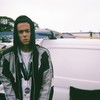It's important, from the offset, to understand the multi-faceted meanings behind the word "blue." It would be a mistake to think that Eiffel 65's lead vocalist Jeffrey Jey is refering solely to the color blue in this instance. While yes, the video does feature actual little blue men (more on that later), it's possible here to read far more into Jey's words. If we take the word blue to mean "sad" or "down," then the opening verse in fact sets out an all-consuming depression incurred by the oppressive suffocation of modern existence. Note that "everything he sees" is blue, as if the world itself, not his soul, is polluted. The world, cold, frigid and icy blue, freezing him inside and outside."Yo listen up here's a story,
About a little guy that lives in a blue world,
And all day and all night and everything he sees,
Is just blue like him inside and outside."
"I have a blue house with a blue window.
Blue is the colour of all that I wear.
Blue are the streets and all the trees are too.
I have a girlfriend and she is so blue."
Perhaps we will never know why the actual fuck somebody wrote that, but one thing's for sure. Whoever they are, they resolutely understood that this song was one of multiple dimensions, of universal significance.Whoever they were, their effort is a testament to the enduring emotional pull of this track. A song that sits somewhere between DJ Otzi's "Hey Baby" and the "Cotton Eye Joe" on a mixtape, yet evokes a thousand years of confusion and anti-climax. A song that with the power to knock "Mambo No.5" off the number one spot. The highest charting Italian song ever in the United States.Don't let anybody tell you this piece of Eurodance is trashy, tacky, badly made pop. It is a paean to the eternal longing, the feeling of loneliness that somehow unites us all. It's Derek Jarman with a kickdrum. This is our story, we are all little guys, sitting in our blue houses, looking through blue windows. Da ba dee. Da ba die.Follow Angus on Twitter."The 3 humans called Eiffel65 saw this transmission and from their Star Ship, they accepted to listen to the Zorotl message : "Hello human friends, my name is Zorotlekuykauo Sushik IV, but friends call me Zorotl. I am very sorry for what happened to you, but please let me explain the real story " After having explained all the story to Eiffel65, Zorotl said " We are , in general peaceful people, and we are in love with the Science-Art that you call Music. With your help, we would like to learn it, and to show you my good intention, if you allow me, I will go on stage to sing your song "Blue" together with you, as a sign of friendship."
